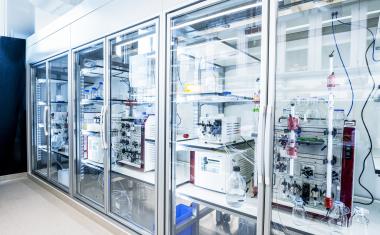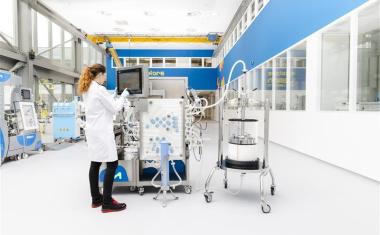China’s Quest for Self-sufficiency in Chemicals
One of China’s key objectives of the current 14th Five-Year Plan is to reduce the dependency on imports. At least partly, this is a reaction to rising political tensions with the USA.

But is also well-aligned with several other longer-term goals of the country, particularly the shift to a more innovative economy that emerges as a global leader in selected new technologies. As we will see, many of the imports particularly in chemicals are of high-end materials that so far cannot be produced domestically.
It also fits in well with the “Dual circulation” policy propagated by Beijing. Domestic-international dual circulation (to give its full name) is a strategy to reorient China's economy by prioritizing domestic consumption ("internal circulation") while remaining open to international trade and investment ("external circulation"). Compared to the situation before the enactment of this policy, it means a stronger focus on the domestic market and less reliance on external trade (both exports and imports).
How self-sufficient is China with regard to chemicals? Recent trade data shows a substantial deficit. From January to August of 2021, the total import and export volume of the Chinese chemical industry was $544 billion, an increase of about 34% compared to the previous year. Of this total, the export amounted to $186 billion while the import was $358 billion, resulting in an overall trade deficit of $172 billion, an increase of 25%.
This may come as a surprise to those who followed US complaints about Chinese trade policies and trade imbalances. However, a slightly more differentiated view explains the situation. While China is indeed a net exporter of commodity chemicals (and even more so, of finished products requiring substantial input of such commodity chemicals), it is a substantial importer of specialty and fine chemicals. In the domestic discussion of the chemical industry, this is described as a "low-end surplus, high-end shortage", a surplus of basic chemicals and a shortage of functional chemicals.
Indeed, in commodity chemicals, overcapacities are far more of an issue than shortages, and this issue is likely to get even more serious. While in 2019 about 60% of all petrochemical products in the Chinese market faced excess supply or severe excess supply, this share is expected to rise to 75% by 2025. For example, for ethylene oxide, China`s capacity/demand ratio is 148% and the capacity utilization rate is 67%. For styrene, the predicted capacity/demand ratio for 2025 is 127% while for PTA, the current production capacity of about 60 million t/a is estimated to increase by an additional 30 million t/a, which would also mean overcapacity. As a consequence, a government-issued list, the "Market Access Negative List (2021 Edition)", puts restrictions on new chemical projects including those in the areas of ethylene, p-xylene, MDI as well as on coal-to-olefins and coal-to-para-xylene projects. If the “Dual circulation” policy is taken seriously, China cannot rely too much on utilizing these overcapacities for exports.
Thus, the self-sufficiency objective clearly focuses on higher-end materials. In a speech given to the National People's Congress in 2021, Yang Hua of Sinochem discussed "the structural contradiction between low-end overcapacity and insufficient high-end supply ... especially in the fields of high-end synthetic materials, functional materials, medical materials, and high-end electronic chemicals.”
A few data points illustrate China’s weakness in high-end chemical materials:
- The share of specialty chemicals as a percentage of the total industry value is only about 45% compared to 60-70% in the US and in many European countries, and 90% in Switzerland
- While there are about 100,000 different fine chemicals produced globally, in China the number reaches only 20,000, according to the Xingyuan Chemical Park Research Institute
- In many high-end segments, China has a low self-sufficiency rate (e.g., 65% for new chemical materials, below 50% in electronic chemicals)
- According to MIIT statistics in 2018, for 32% of the more than 130 key basic chemical materials, China has no local substantial local production while for 52%, China still depends on imports
- All top 10 global specialty chemicals producers are foreign companies
- While China is the largest global consumer of specialty chemicals using about 26% of the global total, this is low compared to China’s overall share of the global chemical market of about 44%, indicating underrepresentation of specialty chemicals
- China’s share of various sub-segment of the global specialty chemical market ranges from 8-46%, again mostly substantially lower than the share in the overall global chemical market
This limited presence in high-end chemicals is a serious concern for China’s government. Many high-level government objectives such as turning China into a global technology leader, decreasing the dependency on strategically important imports such as semiconductors, improving the environmental situation and moving from quantitative to qualitative economic growth strongly depend on high-end chemical materials. In addition, the higher value creation of these materials will also play a role in preventing China from getting stuck in the middle-income trap.
To support specialty and high-end chemicals in China, the government has therefore enacted a number of measures. Some of these take the shape of financial subsidies, e.g., tax incentives for R&D, land grants and preferred access to chemical parks. This includes the creation and upgrading of dedicated fine chemicals parks and the establishment of 10 fine chemical technology centers in new fields to provide technical support
High-end chemicals depend strongly on technological knowledge rather than on production assets. Consequently, China has in the past few years made progress with regard to IP protection, and there have been several court cases in which substantial damages were awarded to companies hurt by IP violations
Multinational chemical companies are also encouraged to invest in higher-end chemical segments in China. In particular, the requirement for the formation of a joint venture with a domestic partner in petrochemicals has been lifted, thus reducing the concern of IP loss when setting up production in China.
Perhaps counterintuitively, some of the measures which at first glance seem to burden the chemical industry in China— such as tightened environmental regulation and the forced shift to chemical parks—may also in the longer run be beneficial for the high-end chemical sector. For one thing, the burden of these measures falls more heavily on small companies with low technology and low-end products. It also gradually leads to the closing down of the weakest, smallest players, to industry consolidation, and to higher prices and margins, which in turn should allow more investment in R&D.
A first consequence of this shifted emphasis is that in the most recent list of top 500 Chinese chemical companies, there are about 100 new entrants, most of which focusing on high-end specialties and replacing basic chemical producers. So, the overall industry structure is already moving towards specialties.
The change can also be seen in the recent activities of some leading Chinese chemical companies. Wanhua is a good example. While a few years ago the company focus was primarily on upstream integration into petrochemicals, the most recent projects clearly focus on specialties in areas such as battery materials, engineering plastics and nutrition.
In conclusion, overall it seems China has understood that as more and more areas of the chemical industry become commoditized, innovation through specialty chemicals is possibly the most important competitive advantage. As a consequence of the resulting support, China is expected to have strong growth in areas such as electronic chemicals, engineering plastics, bio-based materials, metal catalysts, cosmetic chemicals, flavors and others.
Author:

“China has understood that innovation through specialty chemicals is possibly the most important competitive advantage.”


















